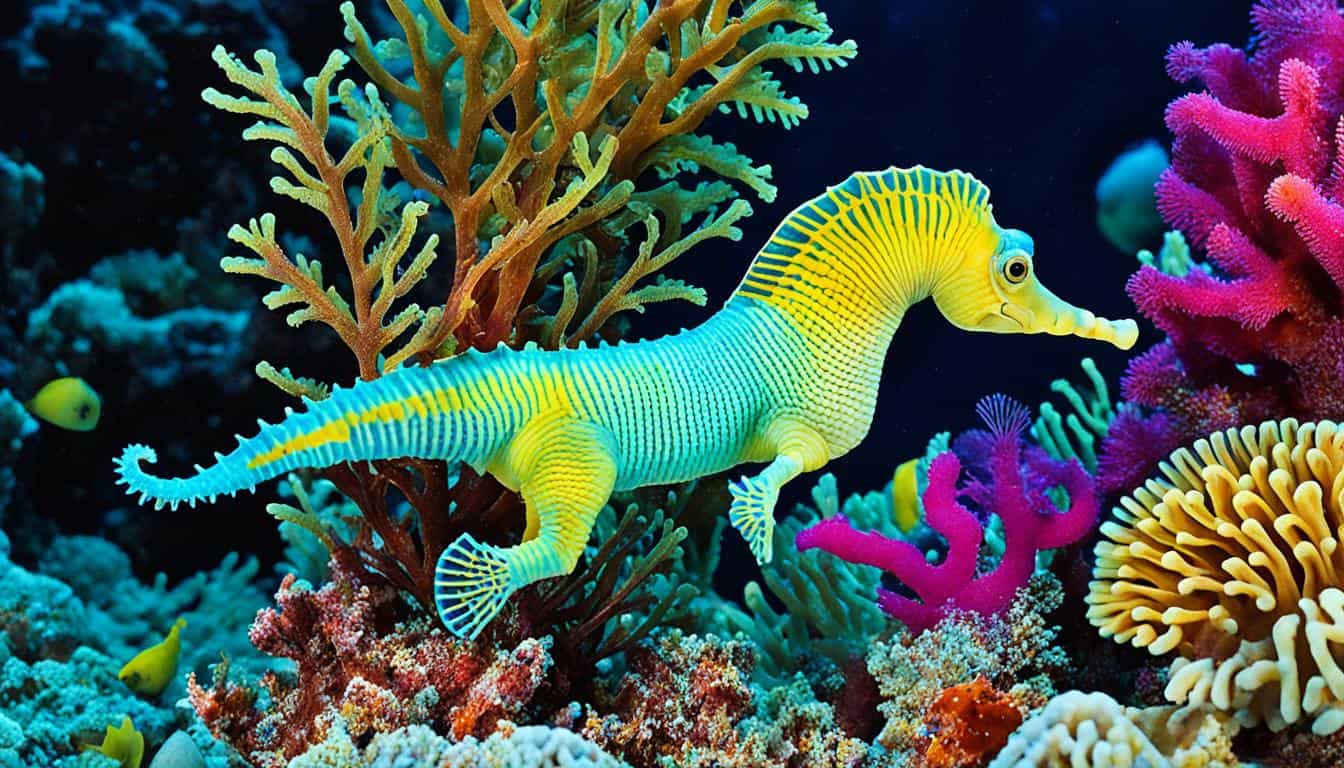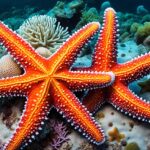Seahorses are amazing marine animals that belong to the Syngnathidae family. They are known scientifically as Hippocampus. There are about 46 different seahorse species, each with its own special features. These fish are famous for swimming upright, looking like a horse, and having a tube-shaped snout and bony armor.
Seahorses usually live for 1 to 5 years and can grow from 0.6 inches to 14 inches long. You can find them in shallow coastal waters, where they hide using their camouflage. Learning about seahorses shows us the beauty of marine life and their amazing adaptations.
Understanding Seahorse Characteristics
Seahorses are truly unique creatures, known for their special traits that make them stand out. Their looks are not just for show; they play a big role in their survival. This part will explore their physical features, size, and colors, showing how they’ve adapted over time.
Physical Features
Seahorses have a long snout that helps them eat. They don’t have scales but have bony plates that protect and bend with them. Each seahorse has a special coronet on their head, making them all unique. They also have spiny plates that help them defend against predators.
Size and Coloration
Seahorses come in all sizes, from 0.6 to 14 inches long. This size range lets them live in many different places. Their colors can change to match their surroundings, helping them hide from threats. This ability to blend in is key to their survival.
What are seahorses?
Seahorses are fascinating creatures that stand out from other fish. They have unique seahorse behavior and seahorse anatomy. Unlike other fish, they swim upright, moving with a special motion of their dorsal fins. This makes them less good at swimming, so they often stick to seagrasses or corals with their tails.
Seahorses can change color to blend in with their surroundings. This helps them hide from predators and survive in different places. They don’t have real stomachs, which makes how they eat very interesting. They eat small things like plankton and small crustaceans by sucking them in with their long snouts.
Learning about seahorses helps us understand their complex biology and behavior. Their unique traits play a big part in their role in the ocean. This shows how marine life is balanced and interconnected.

Seahorse Habitat and Distribution
Understanding where seahorses live is key to their survival. They need places with shelter and food to thrive. Their homes are vital for their life and how many babies they can make.
Preferred Environments
Seahorses live in shallow, warm waters around the world. They like places like:
- Coral reefs, where they find lots of food and places to hide.
- Mangroves, which have calm waters and keep them safe from predators.
- Seagrass beds, which are full of food and perfect for breeding.
Each seahorse type has its own favorite home, depending on the plants in the water. This helps them live well in different places.
Global Presence
Seahorses can be found in oceans from 45°S to 45°N. Different species live in various areas, like:
| Seahorse Species | Common Locations |
|---|---|
| Dwarf Seahorse | Bahamas |
| Sunburst Seahorse | Pacific Ocean |
| Longsnout Seahorse | Atlantic Ocean |
But, seahorses face big threats like pollution, climate change, and overfishing. These issues have made many species vulnerable or endangered. This shows why we need to protect seahorses.
Seahorse Diet and Feeding Behavior
Learning about the seahorse diet and feeding habits helps us understand their place in the ocean. These creatures mainly eat small crustaceans like shrimp and copepods. This diet is key to their survival.
Feeding Mechanism
Seahorses have a unique way of eating. They don’t have teeth, so they can’t chew their food. Instead, they use a long snout to suck in their prey. This method lets them catch small animals quickly without chasing them.
Constant Grazing
Seahorses eat all day long. They don’t have a true stomach, so they digest food fast. To stay energized, they need to eat almost constantly. This eating pattern is crucial for their health and survival in the water.
Seahorse Reproduction and Lifespan
In the world of seahorses, a special role is taken on by males during reproduction. They care for the eggs after the female lays them in their brood pouch. This pouch is a special place for the eggs to grow, lasting from 9 to 45 days. After this, the males release the young into the water, which is a key moment in their lives.
This way of parenting is rare in nature. It shows how dedicated male seahorses are. The young seahorses then face many dangers, with only a few surviving. This makes their early life very tough, showing how important the male’s role is.
FAQ
What are seahorses?
Seahorses are small marine fish in the family Syngnathidae. They have the scientific name Hippocampus. They are known for swimming upright and there are about 46 species.
What are some interesting seahorse facts?
Seahorses have a unique snout, armor plates, and a tail that can grab objects. They hide to protect themselves and need to eat constantly because they don’t have true stomachs.
How do seahorses reproduce?
Seahorses have a special way of reproducing. Males carry the eggs in their brood pouch. The eggs come from the female and develop there before being released as tiny fish.
What are the key characteristics of seahorses?
Seahorses have long snouts, armor plates, and a special crown called a coronet. They range in size from 0.6 to 14 inches and have spiny plates for defense.
Where do seahorses typically live?
Seahorses live in shallow, warm coastal waters. They like coral reefs, mangroves, and seagrass beds for shelter and food.
What is the diet of a seahorse?
Seahorses eat small crustaceans like shrimp and copepods. They use their long snouts to suck in food and must eat almost all the time.
Why are seahorses considered endangered?
Seahorses face threats from pollution, climate change, and overfishing. This has led to many species being listed as vulnerable or endangered.
What is the lifespan of a seahorse?
Seahorses in the wild live about 1 to 5 years. Their lifespan depends on their environment and threats like habitat destruction.
How do seahorses behave?
Seahorses prefer to stay still with their tails anchored instead of swimming. They hide and use camouflage to protect themselves and hunt for food.







